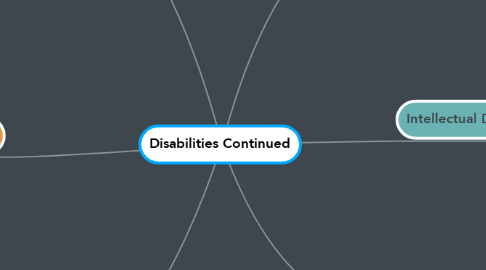
1. Learning Disabilities
1.1. A learning disability can cause a person to have trouble learning and using certain skills. The skills most often affected are: reading, writing, listening, speaking, reasoning, and doing math.
1.1.1. Dyslexia
1.1.2. Dysgraphia
1.1.3. Dyscalculia
1.2. Researchers think that learning disabilities are caused by differences in how a person’s brain works and how it pro- cesses information
1.3. 1 out of every 5 people in the United States has a learning disability.
2. Other Health Impairments
2.1. A health impairment is a medical condition that negatively affects a child's ability to be educated
2.1.1. Diabetes
2.1.2. ADHD
2.1.3. Epilepsy
2.1.4. Hemophilia
2.1.5. Heart Conditions
2.1.6. Lead Poisoning
2.1.7. Leukemia
2.1.8. Nephritis
2.1.9. Rheumatic Fever
2.1.10. Sickle Cell Anemia
2.1.11. Tourette's
3. Speech and Language Impairments
3.1. Problems in articulation, fluency, voice, and language
3.2. language delay isn’t the same thing as a speech or language impairment.
3.2.1. speech and language disorder refers to abnormal language development
3.3. students with a speech or language impairment will need speech-language pathology services.
4. Emotional Disturbance
4.1. typically mental illnesses that affect a child's learning ability
4.1.1. Anxiety
4.1.2. OCD
4.1.3. Eating Disorders
4.1.4. Psychotic Disorders
4.2. it can affect a student in other ways than emotional
4.2.1. Hyperactivity
4.2.2. Withdrawal
4.2.3. Immaturity
4.2.4. Agression
5. Intellectual Disabilities
5.1. Limitations in mental functions that can be caused by many things during and after pregnancy
5.1.1. Used to be referred to as "mental retardation"
5.1.1.1. This is NOT a term we use now
5.1.1.1.1. Rosa's Law
5.2. Communication, fine motor skills, and other milestone behavior develops slowly and much later than a typical child
5.2.1. These skills can be addressed with the right services administered
5.2.1.1. Educational Services
5.2.1.2. Adaptive Skills
5.2.1.3. Transition Planning
6. Visual Impairments
6.1. The terms partially sighted, low vision, legally blind, and totally blind are used in the educational context to describe students with visual impairments.
6.1.1. Loss of vision not an eye disorder
6.2. Because the child cannot see parents or peers, he or she may be unable to imitate social behavior or under- stand nonverbal cues.
6.2.1. Large print materials, books on tape, and braille
6.2.2. Technology in the form of computers and low-vision optical and video aids

